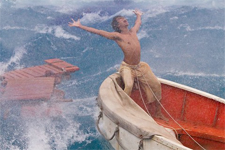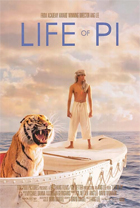Life of Pi
|  The majority of Ang Lee’s Life of Pi takes place on a lifeboat in the middle of the Pacific Ocean, but it has the visual grandeur and majesty of a film set in some fantastical afterlife or on a beautiful alien planet. Based on Yann Martel’s bestselling 2001 novel, the film purports to be an exploration of faith and the existence of God, and one can imagine that Lee’s idea was to use the film’s gorgeous surfaces as the ultimate cinematic invocation of the divine; where philosophers and theologians use words, Lee (Crouching Tiger, Hidden Dragon) is using images. The problem is that the translation doesn’t quite work. The surface of the film is so extraordinary that we get lost in it, and the theological subtext gets buried or, worse, feels distracting. The film is of admirable intent, and even though it doesn’t quite work, it is still quite marvelous in its own way. The majority of Ang Lee’s Life of Pi takes place on a lifeboat in the middle of the Pacific Ocean, but it has the visual grandeur and majesty of a film set in some fantastical afterlife or on a beautiful alien planet. Based on Yann Martel’s bestselling 2001 novel, the film purports to be an exploration of faith and the existence of God, and one can imagine that Lee’s idea was to use the film’s gorgeous surfaces as the ultimate cinematic invocation of the divine; where philosophers and theologians use words, Lee (Crouching Tiger, Hidden Dragon) is using images. The problem is that the translation doesn’t quite work. The surface of the film is so extraordinary that we get lost in it, and the theological subtext gets buried or, worse, feels distracting. The film is of admirable intent, and even though it doesn’t quite work, it is still quite marvelous in its own way.The central character is Pi Patel (Suraj Sharma, a newcomer whose naturalism feels effortless), a teenager from the Indian city of Pondicherry, where his father (Adil Hussain) owns and operates a zoo that, for Pi, is a source of wonderment. A naturally inquisitive child with a thirst for spiritual knowledge, Pi insists that animals have souls while his father insists that anything we see in an animal’s eye is simply our own projection, which creates a nice and tidy metaphor for how we see the divine in our world, as either an inherent trace left by God or a projection of our desire for something that doesn’t exist. Pi’s life is turned upside down when the zoo goes belly up and his father sells it and prepares to move all of the animals and the family to Canada. It is en route to the Western hemisphere that the Japanese cargo ship on which they are traveling meets a massive storm head-on that topples it, drowning everyone on board save Pi and a scraggly group of surviving animals—a hyena, a zebra with a broken leg, an orangutan who shows up riding a floating pile of bananas—who take refuge in one of the lifeboats. Also on board the lifeboat is a Royal Bengal tiger called Richard Parker, and it shouldn’t give too much away to note that soon Pi and the tiger are the only ones left alive, drifting in the middle of a seemingly endless expanse of ocean. (The tiger, which spends so much time in close proximity to Pi, is depicted in a nearly seamless mixture of four real tigers and CGI.) The symbolic importance of Richard Parker was established early in the film when Pi’s father used him as an object lesson in the brutal nature of animals, forcing Pi and his brothers to watch the tiger stalk and kill a goat. “He is not your friend,” his father tells Pi, a declaration that seems more true than ever once Pi is stranded with the tiger in limited confines. Pi’s ingenuity is first displayed in his ability to construct a second floating lifeboat in order to keep his distance, but his soulfulness and resolve come into play as the days stretch into weeks and he realizes that he must find ways to co-exist with Richard Parker, not just stay away from him. Pi’s experience in the lifeboat is relayed via a frame story in which Pi as a middle-aged adult (Irrfan Khan) tells his experience to a cynical young writer (Rafe Spall) looking for a story to tell. Pi insists that his story will cause the writer to believe in God, which is a dangerous pronouncement given how high the stakes are now set for both Pi the character and Life of Pi the film. This is perhaps why the film’s spiritual content ultimately feels a bit thin: It has too much riding on it, which forces screenwriter David Magee (Finding Neverland) to lay it on thick in order to compete with the wondrous images. In a perfect world, the film’s spiritualism—which hedges all bets by having Pi merge everything that is best in Hinduism, Christianity, and Islam—would finds its embodiment in the visuals, but instead they feel in competition, and platitudes and pieties as simply no match for what Lee and cinematographer Claudio Miranda (TRON: Legacy) put on screen. Especially in 3D, Life of Pi is a genuinely visually stunning film whose greatest moments are often its most unexpected. The middle of the ocean is an alien world devoid of human presence, and at times the sky and the water’s surface merge, giving the appearance that Pi and Richard Parker are floating in some ethereal void filled with stars or clouds. Moments of great majestic beauty can turn suddenly horrifying, such as when a whale breaches the phosphorescent water near Pi’s boat, its slow-motion grandeur distracting us and Pi from the inevitably consequences of all that weight going back into the water, which overturns his raft and causes him to lose virtually all of his food. Some sequences feel like the stuff of Arabian Nights fantasy even if they are rooted in natural reality, such as a swarm of flying fish cascading across the lifeboat or a temporary respite on a carnivorous floating island populated by thousands of meerkats. The effect is constantly dazzling and even breathtaking, and had Lee managed to truly merge the spiritual and the visceral, it might very well have been his masterpiece. Copyright ©2012 James Kendrick Thoughts? E-mail James Kendrick All images copyright © 20th Century Fox |
Overall Rating: 

 (3)
(3)


